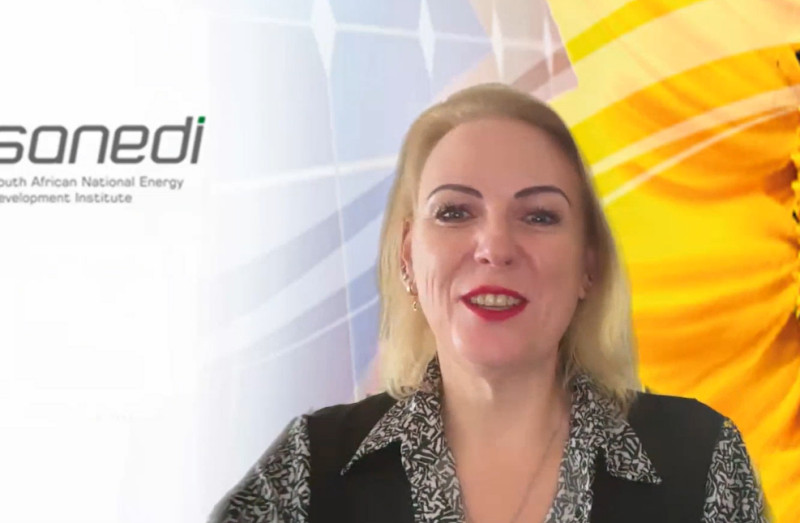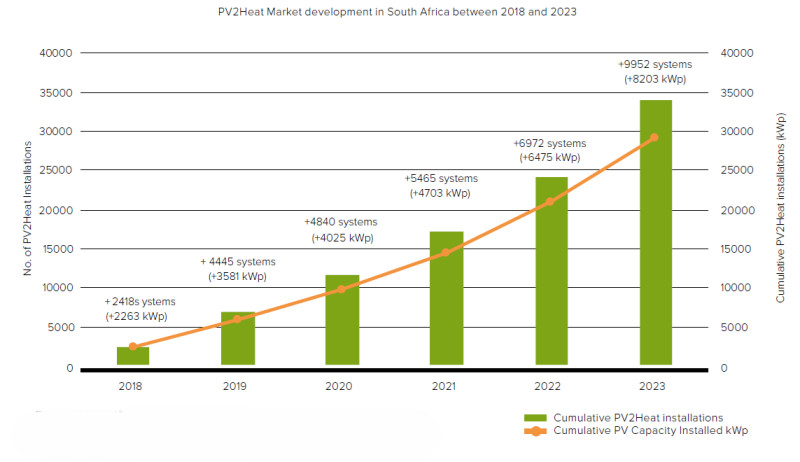Posted: September 6, 2025

Source: Screenshot of the recording of the webinar Adventures in Solar Water Heating
South Africa holds a unique position in the global energy sector for several reasons. It is the largest market for both solar thermal and solar PV in Africa, with a growing demand for PV2heat solutions. However, the country also faces the challenge of being the largest emitter of greenhouse gases in Africa, primarily due to its reliance on coal-fired power plants, and is notorious for frequent load shedding. Dr. Karen Surridge addressed the connection between these factors at the Executive Committee Meeting of the IEA Solar Heating & Cooling Programme in June 2025. As the Project Manager for Renewables and Cleaner Fossil Fuels at SANEDI, the South African National Energy Development Institute, she provided an overview of the current state of solar heat in South Africa.
“The steady rise in electricity prices and frequent power outages are driving demand for PV systems,” reported Surridge. Hence, the photovoltaic sector has grown significantly over the years. At the end of 2024, almost 9 GW of PV capacity was in operation countrywide. This is more than four times as much as in the solar thermal sector. Here, the capacity in operation at the end of 2023 was only 2 GW.
Surridge represents South Africa in the IEA SHC Executive committee. South Africa is the only country in Africa that is directly member of the IEA SHC Programme. Other countries are indirectly connected to the programme because their Regional Sustainable Energy Centres are IEA SHC sponsor.
In recent years, the annual installed collector area in South Africa has remained relatively stable, fluctuating around 150,000 m² per year without showing a clear upward trend. As shown in Figure 1, there have been internal shifts within the market. The share of uncovered collectors used for heating swimming pools has steadily declined, now accounting for only 30 % of the market. This trend is attributed to the weak economy and uncertain future prospects, which have led to hesitancy among consumers when it comes to making significant investments.
Simultaneously, the market share of vacuum tube collectors, imported primarily from China and India, has risen significantly. By 2023, they accounted for half of the collector area sold, a sharp increase from just 28 % a decade earlier. At that time, flat-plate collectors were still being manufactured domestically by a handful of local producers, but they have since shut down due to their higher costs compared to the imported alternatives. "There is no local collector manufacturing capacity left in South Africa; everything is now imported," confirmed Surridge.

Figure 1: Solar collector area annually installed between 2012 and 2023
Source: Solar Heat Worldwide
She cited several reasons why solar thermal energy is not following the growth curve of PV.
So far solar thermal energy is primarily used for domestic hot water. In this segment PV2Heat is a competing solution which is gaining momentum. In this case the direct solar current from the rooftop photovoltaic panel is sent straight to a resistance heater inside a hot water tank.
The annual report Solar Heat Worldwide published the clear growth path of this segment (see figure 2). The market volume quadrupled from 2,418 systems sold in 2018 to 9,952 systems in 2023. “The PV2heat market increases purely because of the constraints that we experience with electrical supply from the grid. There is not really a policy governing this,” explained Surridge.

Figure 2: PV2Heat market development in South Africa between 2018 and 2023 Source: Solar Heat Worldwide
Lack of political support to foster the SHIP market
Surridge notes that the market for mature solar process heat remains underdeveloped, with only nine low-temperature industrial heat installations currently in operation. Furthermore, specialized developers for Solar Heat for Industrial Processes (SHIP) are yet to emerge. Despite the vast potential for carbon-free heat in sectors such as food and beverage, textiles, and recycling, there is a noticeable lack of political support to foster its growth. Currently, the only policy instrument in place is the carbon tax, which was raised to 159 ZAR/tonne CO2 (approximately 9 USD/tonne CO2) in 2023. However, this remains relatively low and insufficient to drive significant change. The law applies to industrial users with an energy-producing capacity of at least 10 MW, covering both heat and electricity production. Surridge emphasized that there is considerable potential for growth and job creation in the field of large-scale solar heat for industrial use.
Solar water heaters show a three times longer lifetime than conventional geysers
Another reason for the more or less constant demand for solar water heaters is the fact that the housing industry opts for air-source heat pumps which are supposedly easier & faster to install. They fulfill the energy building regulation for new buildings within the South African National Standard SANS10400 XA. Part XA2 reads: “A minimum volume fraction of 50 % of the annual average heating requirement for hot water shall be provided by means other than electric resistance heating or fossil fuels. ”The go to response to this regulation is usually a heat pump, however lately we also see some PV2heat systems”, according to Surridge.
When replacing a hot water boiler, households are not obliged to fulfill the renewable share. So generally an electric resistant geyser is switched out for an identical model, when it needs replacing. However, SANEDI points out that solar water heaters show a three times longer lifetime than conventional geysers under the same conditions, achieving significant savings on hardware and electricity costs.
Surridge presented the promising results of a solar hot water system installed at the Defence Force dormitories in the Northern Limpopo Province. The system, which includes two 15 m² collector fields on separate buildings, has been continuously monitored since its commissioning in August 2019. The total investment cost, which included two 1,500-litre storage tanks, amounted to ZAR 2.27 million (USD 127,500). Despite challenges such as frequent electricity and water outages, Surridge reported that the system paid for itself within the first two years of operation.

Solar water heaters support two bungalows at the South African National Defence Force base in Limpopo since 2019 and are monitored by SANEDI.
Photos: Sanedi
Website of organisations mentioned in this news article: